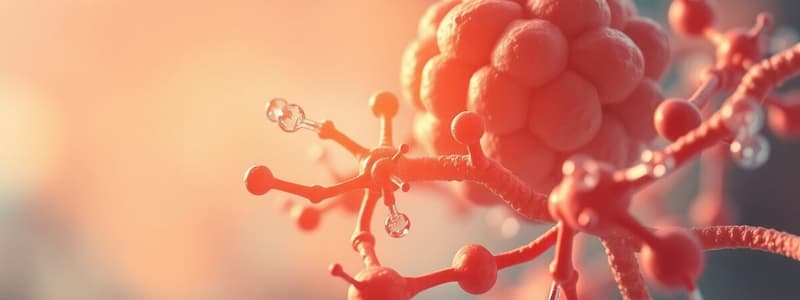Podcast
Questions and Answers
Explain how an enzyme's structure is critical to its function, using the 'lock and key' model. What happens if the 'lock' is damaged?
Explain how an enzyme's structure is critical to its function, using the 'lock and key' model. What happens if the 'lock' is damaged?
The enzyme's active site has a specific shape that only fits specific substrates, like a key in a lock. If the enzyme's shape is changed (denatured), the substrate can't bind, and the enzyme will not work.
During photosynthesis, what happens during the light-dependent stage and how does this stage support the Calvin Cycle?
During photosynthesis, what happens during the light-dependent stage and how does this stage support the Calvin Cycle?
During the light-dependent stage, water is split using light energy and oxygen is released. Then energy (ATP) is produced. This energy (ATP) is then used in the Calvin Cycle to convert carbon dioxide into glucose.
Compare and contrast aerobic and anaerobic respiration in terms of their requirements, products, and overall energy output. Which process is more efficient?
Compare and contrast aerobic and anaerobic respiration in terms of their requirements, products, and overall energy output. Which process is more efficient?
Aerobic respiration requires oxygen and produces carbon dioxide, water, and a large amount of ATP. Anaerobic respiration doesn't need oxygen, produces different byproducts (like lactic acid or alcohol), and yields far less ATP. Aerobic respiration is more efficient.
A plant is placed in a sealed container with a limited supply of carbon dioxide. How will this affect the rate of photosynthesis, and what specific part of the process is directly impacted?
A plant is placed in a sealed container with a limited supply of carbon dioxide. How will this affect the rate of photosynthesis, and what specific part of the process is directly impacted?
How do changes in temperature and pH affect enzyme activity, and why are these factors important in maintaining biological functions?
How do changes in temperature and pH affect enzyme activity, and why are these factors important in maintaining biological functions?
Explain how an enzyme's structure is critical to its function, using the 'lock and key' model and the concept of denaturation.
Explain how an enzyme's structure is critical to its function, using the 'lock and key' model and the concept of denaturation.
Describe the roles of the light-dependent reactions and the Calvin cycle in photosynthesis, and explain how they are interdependent.
Describe the roles of the light-dependent reactions and the Calvin cycle in photosynthesis, and explain how they are interdependent.
Compare and contrast aerobic and anaerobic respiration, noting the reactants, products, and relative amounts of energy (ATP) produced by each.
Compare and contrast aerobic and anaerobic respiration, noting the reactants, products, and relative amounts of energy (ATP) produced by each.
If a plant is placed in an environment with ample light and water but a limited supply of carbon dioxide, how would this affect its ability to perform photosynthesis and produce glucose?
If a plant is placed in an environment with ample light and water but a limited supply of carbon dioxide, how would this affect its ability to perform photosynthesis and produce glucose?
During intense exercise, muscle cells may switch from aerobic to anaerobic respiration. Explain why this switch occurs and what consequences it has at a cellular level.
During intense exercise, muscle cells may switch from aerobic to anaerobic respiration. Explain why this switch occurs and what consequences it has at a cellular level.
Explain how an enzyme's function can be disrupted by changes in temperature or pH, and why this disruption affects its ability to catalyze reactions.
Explain how an enzyme's function can be disrupted by changes in temperature or pH, and why this disruption affects its ability to catalyze reactions.
Describe the roles of the light-dependent reactions and the Calvin cycle in photosynthesis. How are these two stages interconnected?
Describe the roles of the light-dependent reactions and the Calvin cycle in photosynthesis. How are these two stages interconnected?
Compare and contrast aerobic and anaerobic respiration. Include in your answer each type of respiration's inputs, outputs and the relative amount of energy (ATP) each produces.
Compare and contrast aerobic and anaerobic respiration. Include in your answer each type of respiration's inputs, outputs and the relative amount of energy (ATP) each produces.
If a plant is placed in an environment with plentiful light, water and carbon dioxide, but the temperature is significantly below its optimal range, how would this affect the rate of photosynthesis and why?
If a plant is placed in an environment with plentiful light, water and carbon dioxide, but the temperature is significantly below its optimal range, how would this affect the rate of photosynthesis and why?
During intense exercise, muscle cells may switch from aerobic to anaerobic respiration. Explain why this occurs, and what the consequence of this switch is for the muscle cells.
During intense exercise, muscle cells may switch from aerobic to anaerobic respiration. Explain why this occurs, and what the consequence of this switch is for the muscle cells.
Flashcards
Enzymes
Enzymes
Proteins that speed up chemical reactions in the body.
Active site
Active site
The specific region of an enzyme where substrates bind.
Photosynthesis
Photosynthesis
Process by which plants make food using sunlight.
Respiration
Respiration
Signup and view all the flashcards
Aerobic vs Anaerobic respiration
Aerobic vs Anaerobic respiration
Signup and view all the flashcards
Substrate concentration
Substrate concentration
Signup and view all the flashcards
Temperature's effect on enzymes
Temperature's effect on enzymes
Signup and view all the flashcards
Light-dependent stage
Light-dependent stage
Signup and view all the flashcards
Calvin Cycle
Calvin Cycle
Signup and view all the flashcards
Anaerobic respiration
Anaerobic respiration
Signup and view all the flashcards
Enzyme function
Enzyme function
Signup and view all the flashcards
Factors affecting enzymes
Factors affecting enzymes
Signup and view all the flashcards
Photosynthesis equation
Photosynthesis equation
Signup and view all the flashcards
Importance of respiration
Importance of respiration
Signup and view all the flashcards
Types of aerobic respiration
Types of aerobic respiration
Signup and view all the flashcards
Study Notes
Enzymes
- Enzymes are proteins that speed up chemical reactions in the body.
- Substrates fit into the enzyme's active site, like a lock and key.
- Enzymes lower the energy needed for reactions to occur.
- High temperatures or extreme pH levels can denature enzymes, rendering them inactive.
- Substrate concentration affects reaction rate; increasing substrate increases reaction speed up to a certain point.
Photosynthesis
- Photosynthesis is the process plants use to create food (glucose) using sunlight.
- The chemical equation for photosynthesis is: 6CO2 + 6H2O + Light → C6H12O6 + 6O2 (Carbon dioxide + Water + Light → Glucose + Oxygen)
- Photosynthesis occurs in two main stages:
- Light-dependent reactions: Sunlight splits water, creating energy (ATP) and oxygen.
- Calvin cycle: Uses the energy from light-dependent reactions to convert carbon dioxide into glucose.
- Photosynthesis is crucial for producing food for plants and other organisms, and for providing oxygen to the atmosphere.
Respiration
- Respiration is the process of breaking down glucose to produce energy in the form of ATP.
- Two main types of respiration are:
- Aerobic respiration (requires oxygen): Glucose + Oxygen → Carbon dioxide + Water + Energy
- Anaerobic respiration (no oxygen required):
- In animals, glucose is broken down to lactic acid + energy
- In yeast, glucose is broken down to alcohol + carbon dioxide + energy
- Respiration provides energy for all bodily functions, such as movement and growth.
Studying That Suits You
Use AI to generate personalized quizzes and flashcards to suit your learning preferences.




